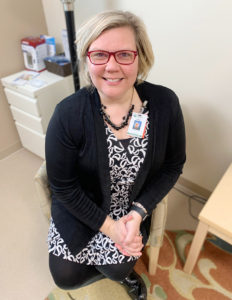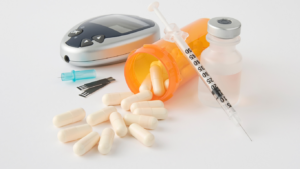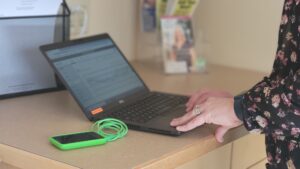
Katie John, FNP-BC
Diabetes Management Provider
It’s time for National Diabetes Month. This November diabetes educators not only want to bring attention to diabetes, but we also want to focus on how you can best utilize community resources like Gifford to help manage diabetes.
So what is diabetes?
The body produces insulin from the pancreas to break down blood sugar so that it can be used for energy. People with diabetes don’t produce enough or no insulin, which is why they need to inject insulin. Some complications can happen due to high blood sugar. It can cause damage to large blood vessels that connect to the heart and brain as well as small blood vessels to the feet, kidneys and eyes. We call them macro and microvascular complications. Our goal is to control blood sugars as well as possible to avoid complications.
What is the difference between type one and type two diabetes?
The main difference between type 1 and type 2 diabetes is that type 1 diabetes is a genetic condition that often shows up early in life, and type 2 is mainly lifestyle-related and develops over time. Approximately 5 to 10% of the population overall in the United States has type one diabetes. The American Diabetes Association estimates about 37 million people in the United States have diabetes.
Type one diabetes used to be thought of as something you’re only diagnosed with as a juvenile, but that’s changed in recent years. You can get type one diabetes at any age, although it still is more prevalent in younger people. We think of type one diabetes as an autoimmune condition where the body attacks itself, especially the pancreas. Beta cells, which are the cells that produce insulin, are affected and they don’t work anymore. Sometimes, it’s a gradual destruction of the pancreas and it happens slowly over time. Other times it’s very quick. Classically, in type one diabetes, it’s quick and sudden. People then need insulin by injection or insulin pump to survive.
With type one diabetes, you can be living your life and then suddenly start getting up multiple times in the middle of the night to go to the bathroom or you’ve lost weight in a pretty dramatic way. Again, type two diabetes can happen more gradually, not having the same kind of really obvious symptoms. Type one diabetes does not go away. There are some experimental treatments, including the transplantation of islet cells. There is tremendous research still ongoing, but for now, type one is forever.
When discussing type two diabetes, it’s about insulin resistance. I always tell people that there are locks on the doors of the cells and insulin is a key that unlocks the doors. Insulin allows sugar to go into muscle cells and brain cells. When you have insulin resistance, there are extra locks on the cells’ doors, whether padlocks or deadbolts. Subsequently, extra keys are required.  The pancreas will make extra keys and they will unlock the doors for a while, but type two diabetes means those extra keys just don’t work anymore. Children can also be diagnosed with type two diabetes, so it’s not just the age that defines the diagnosis.
The pancreas will make extra keys and they will unlock the doors for a while, but type two diabetes means those extra keys just don’t work anymore. Children can also be diagnosed with type two diabetes, so it’s not just the age that defines the diagnosis.
I say that type two diabetes can go into remission. If someone changes their lifestyle and loses weight, whether that’s through diet, exercise, medications, bariatric surgery or some combination of those, they can have no signs of type 2 diabetes any longer. It will be in remission. However, it can return.
There are lots of risk factors for diabetes and they’re not just genetic:
- If you have a first-degree relative with type two diabetes.
- Carrying around extra weight once you reach age 35.
- If you have a Body Mass Index (BMI) of 25 or higher and you’re overweight or obese.
- Cardiovascular issues like hypertension, high blood pressure or high cholesterol.
- Women who have had gestational diabetes or polycystic ovarian syndrome (PCOS).
- Certain ethnicities like African American, Native American, Asian or Latino.
There’s a nice risk calculator on the American Diabetes Association website where you’re asked seven questions and given a risk score. If it’s higher than five, it’s suggested you get screened for diabetes.
What are the symptoms of diabetes?
People with type two diabetes may not have symptoms. If you score high on the ADA test you want to talk with your provider. They’ll often do blood tests and get a fasting blood sugar. Higher than 126 milligrams per deciliter is the diagnosis of diabetes. Another blood test called hemoglobin A-1 C is the average blood glucose over the past three months. When that comes back as higher than 6.5%, that is a diagnosis of diabetes.
When someone has type one diabetes, it can be more than ten years after diagnosis before they develop complications. When someone is first diagnosed with type two diabetes, we start to look for complications early on.
Some of the complications can result in damage to the nerves of the lower extremities, including the feet. There’s a change in the sensation or circulation. Wound healing can also be impacted. If somebody doesn’t feel their feet very well and they accidentally step on something and get an injury, that can lead to a bad infection or wound. Fortunately, the team of Gifford podiatrists specializes in foot care for people with diabetes, evaluating the feet for skin breakdowns or ulcers and working with the patient on a treatment that would avoid any long-term issues.
We have come a long way with diabetes.
The biggest technological impact is continuous glucose monitoring (CGM). Even if someone tests their blood sugar frequently by pricking their fingers, there can be a lot of missing information. A CGM allows the provider and the person with diabetes to look at trends and the direction in which the glucose is moving. These continuous glucose monitors are being integrated with several different automated insulin pumps, which have made an amazing difference. It’s not the artificial pancreas yet, but we’re getting closer. Even your smartwatch can follow your glucose level trends.
 We recommend someone see a diabetes educator when they are first diagnosed to learn more about the diagnosis, talk about their lifestyle and look at areas that could be improved or tweaked. I think sometimes people think that they have to overhaul their whole life if they’ve been diagnosed with type two diabetes. That’s not the case. Small changes can add up.
We recommend someone see a diabetes educator when they are first diagnosed to learn more about the diagnosis, talk about their lifestyle and look at areas that could be improved or tweaked. I think sometimes people think that they have to overhaul their whole life if they’ve been diagnosed with type two diabetes. That’s not the case. Small changes can add up.
There aren’t many diabetes educators in Vermont, so we are spread out to cover a lot of territories. With people traveling long distances for health, having a diabetes clinic in a rural community as Gifford does, makes things more manageable. Often patients feel more comfortable getting good, quality, supportive care in their community versus having to travel to a big medical center. The team at Gifford’s Diabetes Clinic provides education from the first diagnosis. That includes dietary information, how to inject insulin and monitor blood sugar. We also teach patients how to interpret and manage their diabetes using technology.
Jennifer Stratton and I work out of our Kingwood location in Randolph and our Primary Care Clinic in Berlin. Jennifer also travels to the Chelsea and Bethel Health Centers to help to provide some diabetes education in those areas.
On Thursday, December 1 from 9 a.m. to 12 p.m., Gifford is offering a diabetes informational event at the Randolph Medical Center. There are going to be several different presenters including myself, Jennifer Stratton, podiatrist Dr. Jon Bjork, and dietician, Annie Hutchinson. We’re going to be presenting short topics about diabetes, from continuous glucose monitoring to how to take care of your feet. We hope that you’ll be able to come join us and learn a lot.

